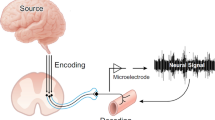Abstract
In order to detect putative differences in the behavioral effects of clozapine and haloperidol, rats were trained to use a single forelimb to exert continuous pressure on a force-sensing operandum. Behavior was maintained by presenting a water-filled dipper for consumption only as long as the force remained above a specified level (the water fountain task). Effects of clozapine (2.0, 4.0, 8.0 mg/kg) and haloperidol (0.02, 0.04, 0.08, 0.12 mg/kg) on the forelimb force oscillations manifested during the operandum pressing episodes were analyzed with power spectral analysis and other quantitative methods. All rats exhibited force oscillations with a fundamental frequency near 7 Hz. Clozapine shifted the frequency to lower values (i.e., oscillation slowing), while haloperidol shifted oscillations to slightly higher frequencies. Moreover, clozapine reduced power in the region of the spectrum above 5 Hz. In contrast, haloperidol tended to increase power in these regions. Time domain analyses of the force-time waveforms indicated that haloperidol increased force emission during the hold phase of the forelimb response, and clozapine decreased this measure. The results are congruent with the high extrapyramidal side effects of haloperidol and the lack of such effects of clozapine in the clinic. In addition, clozapine may have antitremor effects in rats as it does in humans.
Similar content being viewed by others
References
Bersani G, Grispini A, Marini S, Pasini A, Valducci M, Ciani N (1990) 5-HT2 antagonist ritanserin in neuroleptic-induced parkinsonism: a double-blind comparison with orphenadrine and placebo. Clin Neuropharmacol 13:500–506
Bruhwyler J, Chleide E, Houbeau G, Waegeneer N, Mercier M (1993) Differentiation of haloperidol and clozapine using a complex operant schedule in the dog. Pharmacol Biochem Behav 44:181–189
Costall B, Naylor RJ (1975) Detection of the neuroleptic properties of clozapine, sulpiride, and thioridazine. Psychopharmacologia 43:69–74
Faustman WO, Fowler SC, Walker CH (1981) Time course of chronic haloperidol and clozapine upon operant rate and duration. Eur J Pharmacol 70:65–70
Fischer PA, Baas H, Hefner R (1990) Treatment of parkinsonian tremor with clozapine. J Neurotransm (Parkinson's disease dementia section) 2:233–238
Ford KE, Fowler SC, Nail GL (1979) Effects of clozapine and chlorpromazine upon operant response measures in rats. Pharmacol Biochem Behav 11:239–241
Fowler SC (1990) Neuroleptics produce within-session decrements: facts and theories. Drug Dev Res 20:101–116
Fowler SC, LaCerra MM, Ettenberg A (1986) Effects of haloperidol on the biophysical characteristics of operant responding: implications for motor and reinforcement processes. Pharmacol Biochem Behav 25:791–796
Fowler SC, Kirkpatrick MA (1989) Behavior-decrementing effects of low doses of haloperidol result form disruptions in response force and duration. Behav Pharmacol 1:123–132
Fowler SC, Liao RM, Skjoldager PD (1990) A new rodent model for neuroleptic-induced pseudoparkinsonism: low doses of haloperidol increase forelimb tremor in the rat. Behav Neurosci 104:449–456
Fowler SC, Skjoldager PD, Liao R-M, Chase JM, Johnson JS (1991) Distinguishing between haloperidol's and decamethonium's disruptive effects on operant behavior in rats: Use of measurements that complement response rate. J Exper Anal of Behav 56:239–260
Fowler SC, Senyuz L (1993) Effects of haloperidol on a run-climb-run behavioral task: Distance climbed does not alter within-session decrements. Behav Neurosci 107:651–661
Idanpaan-Heikkila J, Alhava E, Olkinuira M, Palva IP (1977) Agranulocytosis during treatment with clozapine. Eur J Clin Pharmacol 11:193–198
Jacobs BL, Fornal CA (1993) 5-HT and motor control: a hypothesis. Trends Neurosci 16:346–352
Kallman MJ, Fowler SC (1994) Assessment of chemically induced alterations in motor function. In: Chang LW (ed) Handbook of neurotoxicology: I. Basic principles and current concepts. Marcel Dekker, Monticello, New York (in press)
Leysen JE, Janssen PMF, Schotte A, Luyten WHML, Megens AAHP (1993) Interactions of antipsychotic drugs with neurotransmitter receptor sites in vitro and in vivo in relation to pharmacological and clinical effects: role of 5HT2 receptors. Psychopharmacology 112[Suppl]:s40-s54
Liao RM, Fowler SC (1990) Haloperidol produces within-session increments in operant response duration in rats. Pharmacol Biochem Behav 36:199–201
Ljungberg T, Ungerstedt U (1979) Evidence that the different properties of haloperidol and clozapine are not explained by differences in anticholinergic potency. Psychopharmacology 60:303–307
Meltzer HY (1992a) Clozapine: pattern of efficacy in treatment resistant schizophrenia. In: Meltzer HY (ed) Novel antipsychotic drugs. Raven Press, New York, pp 33–46
Meltzer HY (1992b) The mechanism of action of clozapine in relation to its clinical advantages. In: Meltzer HY (ed) Novel antipsychotic drugs. Raven Press, New York, pp 1–13
Newland MC (1988) Quantification of motor function in toxicology. Toxicol Lett 43:295–319
Pakkenberg H, Pakkenberg B (1986) Clozapine in the treatment of tremor. Acta Neurol Scand 73:295–297
Rebec GV, Peirson E, McPherson F, Brugge K (1982) Differential sensitivity to amphetamine following long-term treatment with clozapine or haloperidol. Psychopharmacology 77:360–366
Sanger DJ (1985) The effects of clozapine on shuttle-box avoidance responding in rats: comparisons with haloperidol and chlordiazepoxide. Pharmacol Biochem Behav 23:231–236
Tarsy D (1989) Neuroleptic-induced movement disorders. In: Quinn NP, Jenner PG (eds) Disorders of movement: clinical, pharmacological and physiological aspects. Academic Press, New York, pp 361–393
Wiley JL, Compton AD, Porter JH (1993) Effects of four antipsychotics on punished responding in rats. Pharmacol Biochem Behav 45:263–267
Author information
Authors and Affiliations
Rights and permissions
About this article
Cite this article
Fowler, S.C., Davison, K.H. & Stanford, J.A. Unlike haloperidol, clozapine slows and dampens rats' forelimb force oscillations and decreases force output in a press-while-licking behavioral task. Psychopharmacology 116, 19–25 (1994). https://doi.org/10.1007/BF02244866
Received:
Revised:
Issue Date:
DOI: https://doi.org/10.1007/BF02244866




